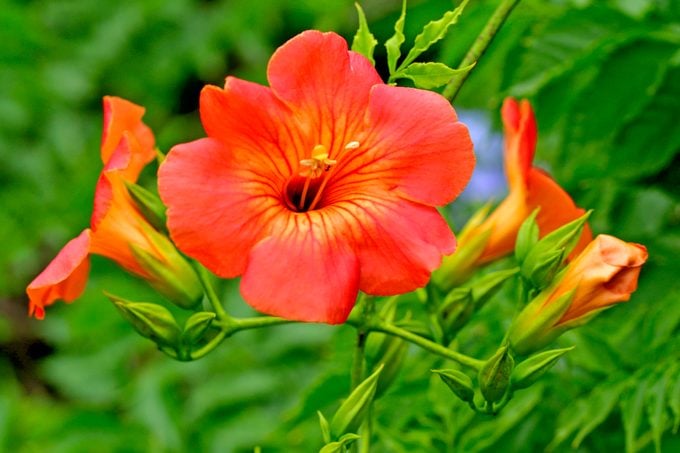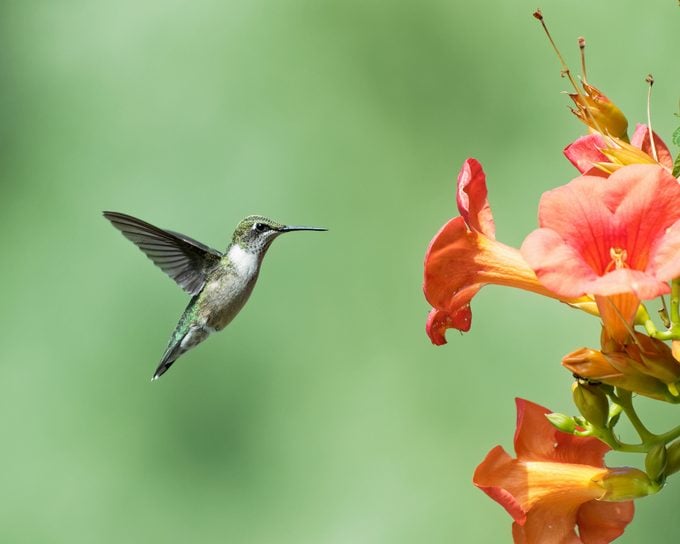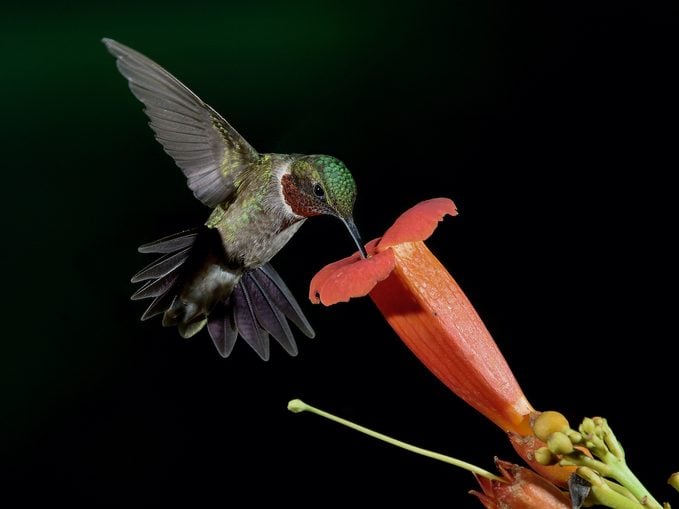Hummingbirds Flock to Trumpet Vine—But Is It Invasive?
Updated: Jul. 22, 2024
In the right landscape, trumpet vine draws hummingbirds and other pollinators in droves. Here's how and where to grow this popular vine.
Trumpet vine is a hummingbird magnet, but it’s not the right fit for every garden. Learn where and how to grow this pollinator favorite, and when you should avoid growing it.
Check out the top 10 red hummingbird flowers to grow.
On This Page
Trumpet Vine Care and Growing Tips

- Botanical name: Campsis radicans
- Other common names: trumpet creeper, devil’s shoestring, cow vine
- Growing zones: 4 to 9
- Size: Vining plant with stems up to 40 feet
- Light needs: Full sun to part shade
- Water needs: Medium
This fast-growing vine is quick to climb high up fences, trees, or other supports using its aerial rootlets. The shiny serrated leaves grow in leaflet pairs of three to six, and the waxy 3- to 4-inch long trumpet-shaped flowers that give it its name are red to reddish-orange. Cultivars like ‘Flava’ have yellow flowers instead. All parts of trumpet vine are mildly toxic, so wear gloves when handling and keep plants away from pets and children.
Horticultural expert Melinda Myers says, “Trumpet vines require patience. First and foremost, they need to reach maturity before they start blooming. This can take several years after planting. They flower best in full sun and moist, well-draining soil with low to average fertility.
Avoid applying high-nitrogen fertilizers to your trumpet vine and nearby gardens and lawns. The plant’s robust root system seeks out nutrients, and high-nitrogen fertilizers encourage leaf and stem growth at the expense of flowers. Some gardeners do some root pruning to counteract this. They take a sharp spade shovel and cut through some of the roots a few feet away from the base of the vine. Don’t overdo the root pruning as you may stunt or otherwise damage the plant.”
Here are the top 10 vines to grow for hummingbirds.
Does Trumpet Vine Attract Hummingbirds?

Those deep flowers hold sweet nectar at their base, drawing hummingbirds in to feast. These birds pollinate the plant, along with bees, butterflies and ants, among others. The leaves also serve as a host plant for the caterpillars of the Plebeian sphinx moth (Paratrea plebeja), too. That makes this blooming vine an all-around winner in a wildlife garden that has the space for it.
Did you know: Trumpet vine can offer hummingbirds up to 10 times more nectar than most plants.
Find more tube-shaped flowers that attract hummingbirds.
Where to Grow Trumpet Vine

Like most vines, this one does best in a place where it can climb. At ground level, it tends to overtake everything around it, so give it a fence, trellis, or even tall tree to clamber up instead. It can also make a cool container plant, especially in hanging baskets where the trailing blooming vines really come into their own.
Trumpet creepers grow well in many soils, as long as they’re well-draining. It’s even drought-tolerant once established. Give it lots of sun to maximize flowering. Individual vines can stretch up to 40 feet long, so provide plenty of room for them to stretch and thrive.
One real advantage to this flowering vine is its deer-resistance. It rarely experiences serious pests and diseases, though powdery mildew and leaf spots can be occasional problems. Remove affected leaves as soon as you see them, and rake up leaf litter in the fall to minimize the issue the following season.
Psst—hummingbirds will also flock to a hummingbird mint plant.
Is Trumpet Vine Invasive?

This wide-ranging plant is native or naturalized across most of the United States: north to New England and south all the way to Florida, and across the central plains into Kansas and Texas. It’s been planted as an ornamental hummingbird plant in many other places across the country.
Even in its native areas, trumpet creeper can quickly become unruly in smaller gardens or landscapes, taking over a space. The aerial roots can damage wood and stone, including on buildings. It may need regular pruning to keep it in check in many landscapes. Cut it back to the ground in early spring to encourage fresh, healthy growth. Then, prune throughout the growing season as needed, wearing gloves to avoid the mildly toxic sap the vines produce.
This vine also travels by roots underground, popping up many feet away from the original planting. Rooting it out can be difficult, so take care in planting it initially. If you have concerns about whether trumpet vine is right for your landscape, consult your local county extension office or a master gardener for advice.
Melinda says, “Though a real hummingbird magnet, the suckering characteristic is a big downside of this vine. Trumpet vine sends up runners that can be challenging to manage. Continually pruning the shoots to the ground as they appear will eventually starve the plant, but you must remove every one. As you discovered, it can take a lot of time and effort. Another option is you can paint the leaves with a total vegetation killer. If you do, be careful not to touch nearby desirable plants and know that repeat applications will be needed. As always, be sure to read and follow label directions.”
Next, learn how to grow nectar-rich native plants for hummingbirds across the country.
Why Trust Us
For nearly 30 years, Birds & Blooms, a Trusted Media Brand, has been inspiring readers to have a lifelong love of birding, gardening and nature. We are the #1 bird and garden magazine in North America and a trusted online resource for over 15 million outdoor enthusiasts annually. Our library of thousands of informative articles and how-tos has been written by trusted journalists and fact-checked by bird and garden experts for accuracy. In addition to our staff of experienced gardeners and bird-watchers, we hire individuals who have years of education and hands-on experience with birding, bird feeding, gardening, butterflies, bugs and more. Learn more about Birds & Blooms, our field editor program, and our submission guidelines.
Sources:
- https://www.missouribotanicalgarden.org/PlantFinder/PlantFinderDetails.aspx?kempercode=b840
- https://www.wildflower.org/plants/result.php?id_plant=cara2
- https://plants.usda.gov/DocumentLibrary/plantguide/pdf/pg_cara2.pdf
- https://www.butterfliesandmoths.org/species/Paratraea-plebeja
- https://portal.ct.gov/CAES/Plant-Pest-Handbook/pphT/Trumpetvine-Campsis
- https://edis.ifas.ufl.edu/publication/FP099
- Birds & Blooms official gardening expert Melinda Myers




















